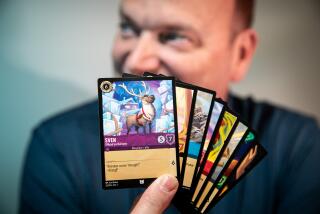Keeping a Hand in the Game
- Share via
Question: What hints do you have for determining that American playing cards, which I collect, were produced in the 19th or 20th centuries?--T.F.
Answer: At the turn of the century, American manufacturers of playing cards began changing their varied design, making them more standardized. Double-headed images on face cards came into vogue. Cards were produced with rounded corners. Suit signs and a card’s value appeared in Arabic numerals in two corners of numbered cards; face cards showed initials in two of the corners.
Therefore, American packs with other than these designs may predate this century.
Collector hints: Although there are still good values to be found in this collectible category--for example, many interesting decks, some with advertising or souvenir themes, sell for well under $50--make sure you have a complete deck of 52 cards before you decide to buy. For many collectors, this includes a joker card as well.
The first American playing cards appear to have been published in Massachusetts in the late 17th Century. The popular Bicycle brand was first manufactured in 1885 by the U.S. Playing Card Co. of Cincinnati.
Mailbag
In the people-collect-everything category, we got a letter from Susan Perry of Los Angeles, who has, by her last count, “at least a thousand” bookmarks of various shapes, sizes and materials.
“Do you know of any publications, clubs or resources that would help me augment my collection?” she wrote.
So unusual a collectible prompted a recent call to Perry, a 41-year-old free-lance writer.
“Nobody seems to collect them,” she lamented. “I started collecting them five years ago.”
When she tells her friends about her collectible interest, Perry said they generally respond with an erudite, “oh.”
Among her most prized bookmarks, she said, were a few made of leather, one with a cloisonne tip and even a paper bookmark dating back to 1910--the latter her most expensive, she said, costing $8. Many of the bookmarks, of course, are advertising vehicles for bookstores.
Why collect bookmarks?
“I love to read and I’m a writer,” she said. “I can use them. They’re inexpensive. They don’t take up space.”
Her current problem, she said, is how to display her collection.
If anyone knows of a bookmark collection or bookmark clubs, call Perry at (213) 667-2638.
Ronald L. Soble cannot answer mail personally but will respond in this column to questions of general interest about collectibles. Do not telephone. Write to Your Collectibles, You section, The Times, Times Mirror Square, Los Angeles 90053.


